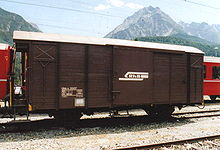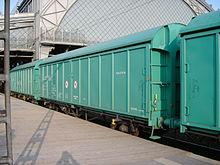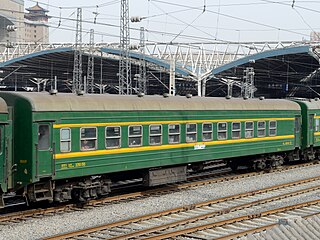
A railroad car, railcar, railway wagon, railway carriage, railway truck, railwagon, railcarriage or railtruck, also called a train car, train wagon, train carriage or train truck, is a vehicle used for the carrying of cargo or passengers on a rail transport network. Such cars, when coupled together and hauled by one or more locomotives, form a train. Alternatively, some passenger cars are self-propelled in which case they may be either single railcars or make up multiple units.
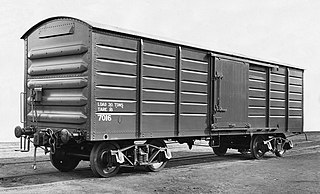
A boxcar is the North American (AAR) term for a railroad car that is enclosed and generally used to carry freight. The boxcar, while not the simplest freight car design, is considered one of the most versatile since it can carry most loads. Boxcars have side sliding doors of varying size and operation, and some include end doors and adjustable bulkheads to load very large items.

Rail freight transport is the use of railways and trains to transport cargo as opposed to human passengers.

The German term Verbandsbauart describes both a type of goods wagon as well as a type of tram.

Goods wagons or freight wagons, also known as goods carriages, goods trucks, freight carriages or freight trucks, are unpowered railway vehicles that are used for the transportation of cargo. A variety of wagon types are in use to handle different types of goods, but all goods wagons in a regional network typically have standardized couplers and other fittings, such as hoses for air brakes, allowing different wagon types to be assembled into trains. For tracking and identification purposes, goods wagons are generally assigned a unique identifier, typically a UIC wagon number, or in North America, a company reporting mark plus a company specific serial number.

The system of German railway wagon classes (Wagengattungen) was introduced in Germany in 1902 and 1905 by the Prussian state railways based on their system of norms, and was soon taken up by the other state railways (Länderbahnen). On the formation of the Deutsche Reichsbahn, the system became mandatory across the whole of Germany. In the course of the years more and more adjustments to it were made. It was finally replaced between 1964 and 1968 when the two German railway administrations - the Deutsche Bundesbahn and the Deutsche Reichsbahn - adopted the internationally standard UIC classifications for passenger coaches and goods wagons. Today, the system is still regularly being used for narrow gauge goods wagons, because these were not generally given UIC designations, as well as on many historical vehicles.
The Royal Bavarian State Railways had, at different times, three different goods wagon classification systems that roughly correspond to the early, middle and late period of the state railway era in Bavaria:
The so-called Austauschbauart wagons were German railway vehicles produced from the late 1920s onwards which had common components built to agreed standards.

Kriegsbauart refers to railway goods wagon classes that were developed during the Second World War for the Deutsche Reichsbahn. The start of the war was an arbitrary dividing line for the classification of goods wagons, and did not represent any technological change. In the period shortly before the war, goods wagons were already being designed from a military perspective. This was particularly true for the stake wagons of 1938, which are occasionally referred to as a 'pre-war class' (Vorkriegsbauart) of wagons.

Open wagons form a large group of railway goods wagons designed primarily for the transportation of bulk goods that are not moisture-retentive and can usually be tipped, dumped or shovelled. The International Union of Railways (UIC) distinguishes between ordinary wagons and special wagons (F/6). Open wagons often form a significant part of a railway company's goods wagon fleet; for example, forming just under 40% of the Deutsche Bahn's total goods wagon stock in Germany.
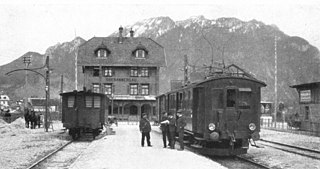
A Lokalbahn or Localbahn is a secondary railway line worked by local trains serving rural areas, typically in Austria and the south German states of Bavaria and Baden-Württemberg. Lokalbahnen appeared at the end of the 19th century before the use of cars became widespread.

Flat wagons, as classified by the International Union of Railways (UIC), are railway goods wagons that have a flat, usually full-length, deck and little or no superstructure. By contrast, open wagons have high side and end walls and covered goods wagons have a fixed roof and sides. Flat wagons are often designed for the transportation of goods that are not weather-sensitive. Some flat wagons are able to be covered completely by tarpaulins or hoods and are therefore suitable for the transport of weather-sensitive goods. Unlike a "goods wagon with opening roof", the loading area of a flat is entirely open and accessible once the cover is removed.

This list contains the UIC classification of goods wagons and their meanings. The description is made up of a category letter and usually several index letters.
The covered goods wagons of classes Glrhs Dresden and Gltrhs Dresden were first placed in service in Germany by the Deutsche Reichsbahn-Gesellschaft in 1937. The wartime (Kriegsbauart) wagon, the DRB Glmhs Leipzig, and the wartime passenger wagon, the DRB MCi-43, were based on the Dresden classes.
The International Union of Railways groups all special classes of railway goods wagon into Class U in its goods wagon classification system.
Unlike the broad-gauge, the Victorian Railways' 2 ft 6 in narrow-gauge network never had four-wheeled trucks. Instead, a single design of 249 underframes was constructed, with identical structure, bogies, couplers and brake equipment. Different bodies were provided on these frames for each purpose. The most common, by far, was the convertible flat/open truck, followed by cattle, louvred, insulated and boxcar types.
The wagon with opening roof is a type of railway goods wagon that is, nowadays, defined and standardised by the International Union of Railways (UIC) as Class "T". They are a large category of rail vehicle, predominantly used for the transport of hygroscopic bulk commodities such as cement, plaster, lime, potash and grain.
The Victorian Railways used a variety of air-cooled and iced wagons for the transport of all manner of goods. This page covers the history and development of the various classes, and how they changed through their lives.
A cattle wagon or a livestock wagon is a type of railway vehicle designed to carry livestock. Within the classification system of the International Union of Railways they fall under Class H - special covered wagons - which, in turn are part of the group of covered goods wagons, although cattle have historically also been transported in open goods wagons. The American equivalent is called a stock car.
Goods wagons of welded construction were developed and built by the Deutsche Reichsbahn in Germany from 1933 to about 1945. With the introduction of welding technology in 1933 almost all wagon components were joined by welding and no longer by rivetting. This enabled goods wagons to be designed, for example, for higher speeds or for higher payloads through the use of different types of steel and other engineering changes, but their further development was so heavily influenced by the exigencies of the Second World War that, as early as 1939, the Deutsche Reichsbahn had to temper the design of goods wagons to the new economic circumstances. Because there were overlaps in the change from the Austauschbauart - goods wagons made with interchangeable components - to the new welded classes, the period of the changeover cannot be exactly defined. Several standard goods wagons and their classes are covered in other articles. Goods wagons built during the Second World War that were purely intended for military transport use, are covered under the article on Kriegsbauart - wartime classes.
